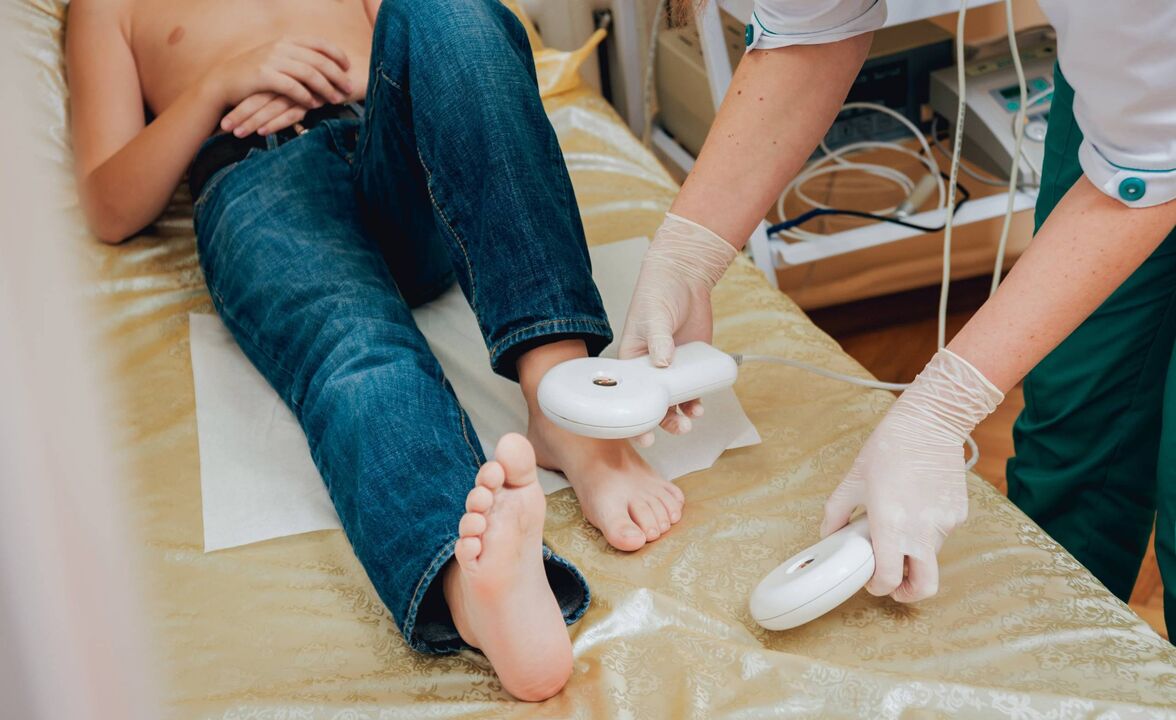Nail fungus - an infectious disease that affects the nail plate. In severe current form, it goes to the skin roller and can spread to other areas. Activation of pathogenic microorganisms is possible when visiting public places, while wearing tight shoes, with poor immunity, injury.
About the onset of the development of the disease, the color changes in the affected area, the extension of the nail, the tenderness, the pain, the unpleasant and the unpleasant odor indicates the color change in the affected area. Diagnosis includes bacterial particles from affected areas, histology, cultural examination, blood tests. Drug treatment. In some cases, surgical intervention is required.
Contrary to the opinion that a person's nail shoes are influenced by fungal infections should be removed, this is not.
It must be treated with special tools, which, when placed inside, emits ultraviolet radiation and killing mushrooms.
It is also allowed to use a 40-%vinegar solution diluted in water. The shoes are rubbed from the inside with the composition of the resulting and placed in a sealed bag for several hours.
What is nail fungus
Although onychomycosis (nail fungal infection) is not a danger to life-this is an important issue of public health care due to high inconvenience and therapeutic difficulties associated with high-end and chronic lesions development. It has certain consequences for patients, such as discomfort and painful reactions.
Dermatophytes are usually responsible for onchomycosis in countries with moderate climate. Destroying keratin and absorbing its nutrients, they represent a form of hyaline septic. Gif from this mycelial organism penetrates the nail and nail layers.
Fungk cells produce keratinolithic proteases that provide a way to enter the living cells. Some species are mainly soil saprophytes that gain the ability to digest keratin particles and develop so that they can parasitize animal keratin tissue.
The term "dermatophytosis" is used to describe infections by members of Microsporum, Trichophyte and Epidermophyte. Types of types most often cause onychomycosis - red trichophyte, trichophyte mentagrofitest and flap -shaped epidermophyte (epidermophytosis pathogen): The first two are more often accompanied as a causal factor.
Only one red trichophyte is responsible for more than 80% onychomycosis. Skin, hair, nail infections of incomplete form (traveler and scopulariopsis) are called "dermatomycosis. " Second -two dermatophytes and incidents are identified as the only onychomycosis etiological agents.
Infections begin with color changes and nail deformations, which cause pain and complicate their haircut. In patients with complicated factors, it causes damage to the surrounding tissue, can contribute to secondary bacterial infections.
In addition, these new studies have revealed the psychological, social and professional consequences of the situation, which appear to be underestimated by healthcare experts in the treatment of this condition.
Doctors note that nail fungus is a common problem that can affect people of all ages. The main symptoms include changes in nail color, thickening and their softness. Experts emphasize that the important aspect of treatment is early diagnosis, as extended cases may require longer and more complicated treatment. Doctors are recommended to use local and systemic antifungal drugs, depending on the degree of damage. In addition, they focus on the need to adhere to the norms of hygiene and preventive measures, such as wearing simple shoes and the use of individual foot care. It is also important to keep in mind that fungus can be transmitted from person to person, so ordinary bathrooms and baths should be avoided.
How to treat nail fungus?
Statistics
Fungal damage to the nails is subject to 5 to 15% of the population. With age, the prevalence of pathological processes increased to about 30% after 65 years. However, it should be noted that often fungus occurs in children.
About 10 years, the incident rate increases 2. 5 times. At the same time, in childhood, it was only 3%, while in adult population up to 60%.
Unlike women, men are more affected by men. In addition, the pathological process of 3-7 times more often affects the lower limbs than the above.
All varieties of parasitic mushrooms are combined into 3 groups.

Scraping to Fungus Skin
The lesion of the fungus is one of the most common pathologies that belong to skin diseases.
In 80% of patients, the disease develops against the background of the reproduction of dermatophytes.
Explosive parasites are 5 times more likely to be localized on the nails of the hands. Mold mushrooms are the rarest species.
In people with diabetes mellitus, the incidence rate is 3 times higher. In 90% of people with psoriasis, the probability of infection also increases by 2 times.
Cause
Risk factor is contact with the source of infection. For example, trichophyte verrucosum, evolving from Ancestors living in the soil, infects farmers, agricultural workers, veterinarians. It is transmitted through direct contact or bites, although cases of infection obtained in the laboratory were also registered.
Several factors unique to modern life LED to the prevalence of onychomycosis. These include:
- Wearing Tightshoesin high heels;
- Using CommonwetPremises (as shower and locker rooms);
- The deterioration of healthagingresidents;
- an increase in the number of weak peopleimmunitycaused by disease (for example, HIV infection);
- Therapeuticagents (immunosuppressants, postoperative therapy, wide spectrum antibiotic use);
- straightinjurynails, including certain identity disorders (nails bite);
- Genetictendency.

Nail fungal treatment with laser
Nail fungal laser therapy is an effective hardware method that helps speed up recovery.
True fungal infections are found on the toenails more often than on the fingernails. This is due to the fact that they are subject to greater friction and sweat. Stockings and shoes contribute to a dark and damp fungus environment.
The causes may include poor peripheral blood circulation, diabetes, recurrent nail injury, inability or refusal to properly cut nails on the feet and maintain proper care for them. The risk of age and through nail disease.
Many people face nail fungus problems, and their opinions are very diverse. Some think this is not only aesthetic problem, but also a serious illness that requires a full approach. Many share their treatment experiences, talking about a variety of folk medicine and medicines. Some notes that fungus can return even after successful treatment, which causes frustration and fear of germs. Others emphasize the importance of prevention, advice to monitor hygiene and avoid public places with high humidity. In general, discussions on nail fungus are often accompanied by tips and suggestions, which shows the prevalence and relevance of problems in society.
Nail fungus. Treatment of a neglected nail fungus
Type
The prevalence of nail fungus varies around the world due to several cultural and socio-economic factors. That is, it depends on the geographic reion, the population, the myrian features and the diagnostic method used.
Four types of onychomycosis, characterized by clinical manifestations and intrusion pathways, have been identified.
Onychomycosis of distal and lateral submarine
It is observed in most cases and is almost always caused by dermatophytic infections. It acts on hyponichia, usually along the side of the side, spreading proximal along the nail bed, leading to sub -hepherdia and onchilolysis, although the nail plate was not initially affected.
It can be restricted by one side and spread on the side, covering the entire nail and progressing steadily until it reaches the back nail roller.
Finally, the nail plate becomes loose, can be split, often due to injury, although the destruction is most likely to be associated with invasion with dermatophytes that have keratolytic properties. The surrounding skin examination almost always reveals signs of dermatofitosis.
Onychomycosis of shallow white
This is a dermatophytic infection caused by trichophyton mentagrofitest. The less common varieties affect the surface of the nail plate, which acquire white and appear to be exfoliated (but onycholysis is not a feature of onchiomycosis).
It occurs that the wrong diagnosis can be made when it is taken for "keratin granulation" (reaction to polishing nails). To confirm, it is necessary to conduct a laboratory test.
Onychomycosis proximal tray
A rare form of dermatophytic infection, is often associated with warehouse disease. The pathogeny fungus attacks the eponichia nail plate and the nail matrix. It occurs in immunosuppressive patients.
Onychomycosis candidiasis
Another name is a nail infection with yeast candida, classified by:
- chronicParonichiawith secondary nails dysfunction;
- chronicCandidiasismucous membranes;
- Distalinfectionnails;
- secondaryCandidiasis.

Prevention of nail fungus
Nail and foot fungus is a contagious disease caused by pathogenic bacteria.
Distal infection with yeast is rare (in patients with Raynaud's disease or another form of vascular failure).
Chronic paronichia occurs in raw conditions. The swelling of the back of the nail is secondary in relation to the chronic wet condition. The cuticle, which separates from the nail plate, loses the waterproof properties. Microorganisms penetrate the subcutaneous space, which evokes the swelling of the posterior folds.
Chronic mucous loop candidiasis covers the mucous membranes, which is caused by a decrease in cell immunity. The clinical signs vary -differently depending on the severity of the immunosuppression, in cases of severe nail thickening.
Secondary candidal onychomycosis occurs due to several nail diseases, especially psoriasis.
The amount of dystrophic onychomycosis is used to describe the nail disease at the last stage, although some doctors consider it a separate subtype. It can be the end result of the four main models of onchomycosis.
Symptom
The most common symptoms of fungus are extensions of nails and color changes in white, black, yellow or green. When the infection lasts from the beginning to a neglected form, it becomes fragile, the pieces are broken from it. If you do not treat, then the skin under the nails and around the inflammation, pain or peel. There is an unpleasant odor.
Onychomycosis in patients with poor immunity is a very serious health problem. Not only is severe infection serving as a persistent reminder to the patient about his severe condition, but it is possible to transfer fungal pathogens to others.
Diagnostics
Clinical representation of defective nails should warn your doctor about the possibility of onhomycosis. But because mushrooms are the cause of only half of all lesions, be careful to identify the signs and symptoms of other diseases that simulate onychomycosis and distinguish different etiology.
These include psoriasis, lichen, bacterial infections, contact dermatitis, traumatic onichestrophy, congenital pachionichia, yellow nail syndrome, idiopathic onycholysis. Repeated nail injuries can cause distal oncholis - occupation of damaged areas with pigmentation microorganisms.
The use of appropriate diagnostic methods includes:
- smear,potassium treated with potassium hydroxide;
- electionfungal culture (from selected materials: curettage or nail fragments);
- Histology.
The first step in the sampling process is the thorough cleansing of the nail area from alcohol (bacteria) of alcohol. Because the place of aggression and localization of the infection varies in the type of onchomycosis, different approaches are used to obtain optimal samples depending on the diagnosis.
Treatment
The main goal of treatment is to destroy the body shown by microscopy and culture. Clinical improvement - secondary and strict systems to evaluate nail abnormalities.
It is important to acknowledge that the destruction of successful fungus does not always lead to the right shape of the nails, as they can be defective in the infection.
The main method of treatment is relevant or oral antifungal drugs:
- VarnishThey consist of effective number of antifungal agents in transparent, stable, and filming mediums. When applying to nails, the composition provides a solid, transparent waterproof film.
- OralPreparation that falls directly into the bloodstream and, moving through the liver, increases the likelihood of solving problems. However, they have side effects, can cause negative reactions in combination with other drugs.
The main task is how to determine mycosis and provide relevant treatment. At this stage, some related drugs are only in development and testing. Those in the pharmaceutical market are unable to provide a complete guarantee of healing.
To overcome traditional composition restrictions, an effective system is needed that can deliver antifungal agents deep into the nails.
For example, the chemical processing (keratolytic) of the affected area, which, seems to increase the results. Keratolytic agents, such as papain, urea and salicylic acid, are used to increase the penetration of antifungal drugs.
Prevention
Everyone is closest to seeing nails and can quickly recognize any changes. Even with fungal infections, compliance with preventive measures is strongly recommended. After daily washing, the feet are carefully applied, especially drying between the fingers.
It is best to wear cotton socks, using good powder or foot spray. The nails should be trimmed neatly. Both manicures and pedicures can be useful and sometimes allow you to actually get rid of organisms (in the early stages of infection).
In the past decade, great success has occurred in the development of effective and safe medicine, but nail fungus may remain a disease of modern civilization, which is difficult to get rid of. The environmental conditions that contribute to this are associated with life expectancy and more and more people are experiencing weak immunity.
Perhaps the most important task of today is the accurate diagnosis of the causal agent, which enables the optimal choice of antifungal drugs, the spectrum of activities that include infecting microorganisms.
Questions
What is the most effective remedy for nails?
The active ingredient of naphthyfin hydrochloride quickly penetrates the lesion, destroying pathogenic microorganisms at the cell level. The solution and nail polish contain amorolphin hydrochloride.
How do I get fungus on your nails at home?
One week a week, it is recommended to make a bath for warm water (37-38 degrees Celsius) with the addition of sea salt (100 g) or a pinch of citric acid (50 g per 5 liters of water). Because fungus is afraid of the acidic environment, such therapies help reduce the amount of fungal cells on the skin and nails.
What is the fungus on the fearful nails?
What is the fungus on the fearful nails? Onychomycosis does not like exposure to baking salts, hydrochloric solutions, hydrogen peroxide, temperature exposure exceeds 60 degrees.
Is it possible to cure vinegar and nail fungus soda?
Often, with nail fungus, vinegar solutions, soda, iodine, celandine or herbs are used. However, these funds can only solve superficial problems. If the fungus has entered the nail bed and the matrix, the people's methods will be in vain. Instead, they often cause inflammation, irritating soft tissue.
Advis
Council No. 1
Spend the nail condition regularly. Note changes in color, texture and nail shape. Early fungal detection will help prevent spreading and facilitating treatment.
Council No. 2
Mront your feet in dryness. Fungus prefers wet environment, so try to wear breathing shoes and change socks as often as possible, especially after physical activity or hot weather.
Council No. 3
Avoid public places with high humidity, such as sauna, swimming pool and locker room. If you still need to go there, use special protective shoes or slippers to minimize the risk of infection.
Council No. 4
Contact your doctor at the first signs of fungus. Do not alleviate yourself, as improper treatment can worsen the problem. Experts will be able to prescribe effective medications and provide suggestions for nail care.
















